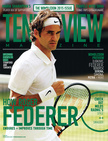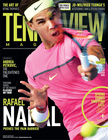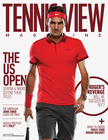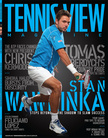Don't miss any stories → Follow Tennis View
FollowHow Novak Djokovic Can Solve the Roland Garros Riddle
Confidence is a fragile thing. What an amazing year Rafael Nadal had last year, and what an incredible comeback season. Yet now, some months into 2014 and a few surprising defeats and physical niggles later, the Spaniard openly admits that he is a little short on that important, elusive, fragile, thing called confidence.
Nadal surely is looking forward to the second Grand Slam of the year, the French Open, where he has lost just once in nine appearances. This record creates an extraordinary psychological edge for him at that tournament. His history will provide him with inner belief and mental resource in every difficult situation on the courts of Roland Garros. Despite what has happened this season so far, Nadal’s record at this tournament speaks for itself and of the unique consistency he is capable of producing in those specific conditions, regardless of opponent or form or weather.
This is a fascinating psychological situation that in turn creates a fascinating dilemma. As an opponent, how do you approach, tackle and turn the psychological situation? One must nullify Nadal’s psychological advantage just to give oneself the possibility of stopping the Spaniard.

Most observers would agree that world No. 2 Novak Djokovic is the contender most capable of defeating Nadal in a five-set match on clay. First of all, Djokovic has the physical abilities, from speed and power to endurance and agility, that anyone needs to stay with Nadal in a typically grueling clay-court battle. And skills-wise, the Serb has showed that he can match Nadal in terms of solidity, consistency, and explosiveness on both the forehand and backhand sides.
This takes us back to the beginning: the psychological situation and approach needed from Djokovic to topple Nadal and complete the career Grand Slam. To use the official language, we have now reached the area of Psychological Skills Training (PST), defined as the “practice of mental or psychological skills for the purpose of enhancing performance.”
There are a number of recognized techniques and methods that an athlete can use as part of PST, such as imagery and goal-setting or the more recent Mindfullness-Acceptance-Commitment (MAC) approach. The main function of any of them goes back to the core goal of sports psychology: giving the athlete the best possible circumstances to perform. This sounds overly simplistic, but this is the psychological challenge Djokovic faces. He must tackle the daunting mental situation to give himself the best possible chance of defeat Nadal.
Within the core task of sports psychology, each athlete must have a certain amount of freedom to tailor a psychological approach to the situation and personality. For example, the MAC approach tries to treat all emotional and cognitive reactions as natural causes to accept and nothing to judge. This is a useful tool in keeping yourself cool and concentrated in sporting situations when your temper is threatening to boil over. Björn Borg is a perfect example of how such an approach can benefit an athlete’s performance, even though the theory was not launched when he played.
But each athlete is different, and their psychological approaches should be different too. Djokovic, at least as an athlete, is an extrovert. He used to have some issues with his temper, but those have dwindled in recent years because of the tremendous confidence his success during that time have given him. Fewer and fewer situations stress and alarm Djokovic anymore. His case actually illustrates the classic cliché of “seeing challenges instead of problems.”

With Djokovic’s extroverted, confident personality, the MAC approach would restrict him and have a negative, “bottling up” effect. In tennis terms, this philosophy advises you to instantly forget your last point, neither reflecting on it nor judging your performance. But Djokovic plays at his best when he can feed off the crowd and feed off his own performance.
When he pulls off one of his trademark shots by showing off incredible physique and agility, getting impossible after impossible ball back into play, and then turning and winning the point with his sublime talent, there is a special intensity of concentration or electricity about him. Confident and at ease, Djokovic is a crowd-pleaser and an entertainer. When he is at his best, he feeds off his last point, off his own brilliance, and off the admiration and reaction of the spectators.
Thus, for Djokovic to reach his optimal psychological state for performance, he must reach an internal state where he is excited and where he feels he gives the crowd something special. But how should he work toward and reach this optimal state of mind? We should go back to the basics of sports psychology and the three cornerstones of the PST pyramid: thoughts, emotions, and behavior.
These three main pillars of PST are constantly reacting to and feeding off each other. If Djokovic behaves in the right way in a certain situation, it will have a positive effect on his thoughts and emotions. Taken together, all of those elements give him a better chance of performing at the top of his game.
What Djokovic must do is behave as he behaves when he is in the ”zone” and plays with a smile on his face, without any of the fear or worries that can easily creep into an athlete’s game. Behaviorally, that means interacting and celebrating with the crowd after good points. It means applauding the opponent when he has produced a shot that was simply too good, projecting confidence and positive emotion.

By thrusting himself into the right psychological space, even against his instincts, Djokovic can give himself the best possible opportunity to conquer his rival and complete the career Grand Slam.










